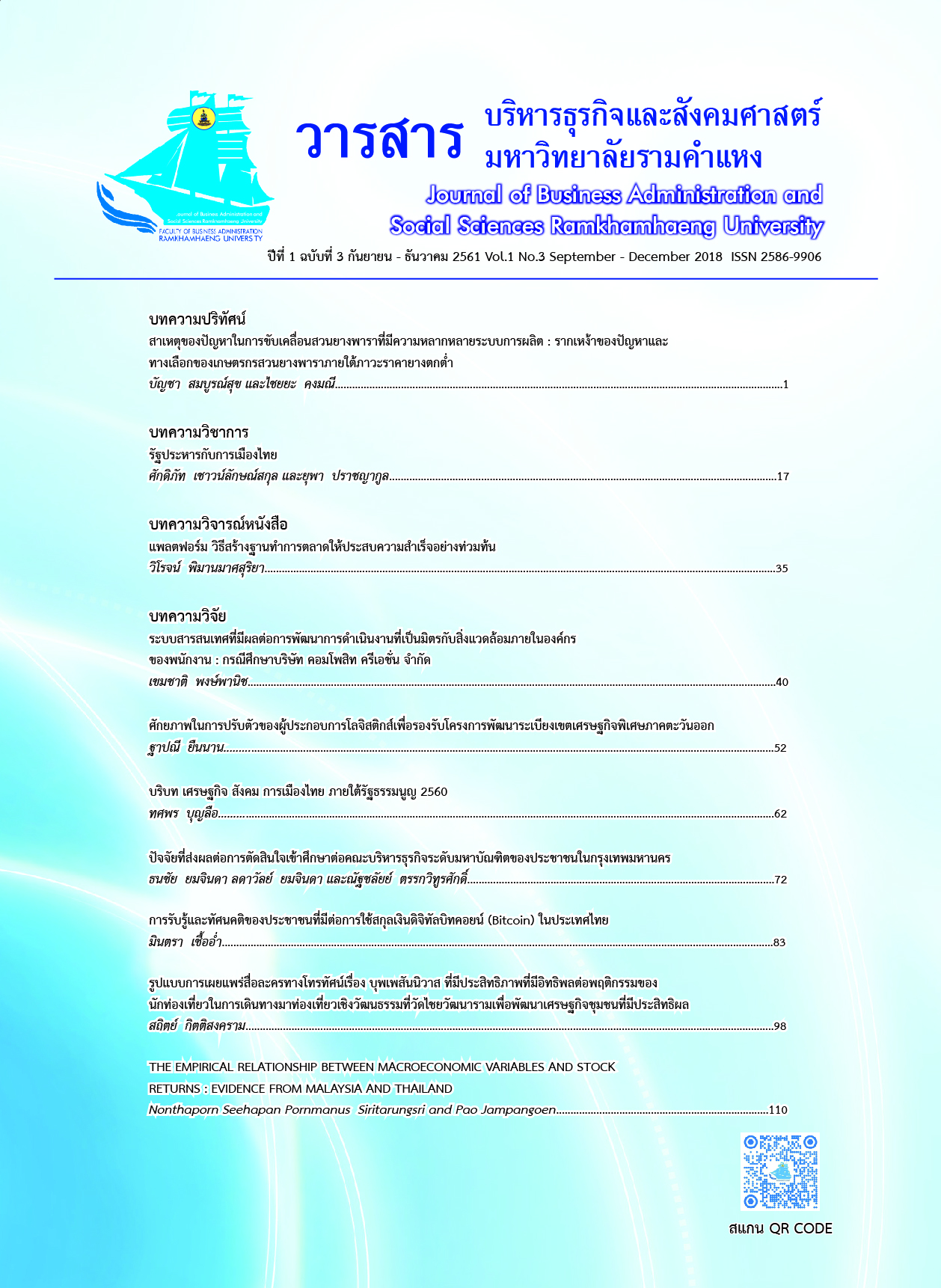CAUSES OF PROBLEMS IN DRIVING DIVERSIFY PRODUCTION SYSTEMS IN RUBBER PLANTATIONS: ROOTS OF PROBLEMS AND ALTERNATIVES OF RUBBER FARMERS UNDER DECLINING RUBBER PRICES
Main Article Content
Abstract
This article aims to analyze the cause of the problems in driving diversify production systems in rubber plantations and also suggest policy options for driving diversify production systems in rubber plantations for sustainable development. Rubber mono - specific cropping plantations were dominated in Thailand. There is a delay policy implement in driving diversify production systems in rubber plantations. A small number of farmers do intercropping rubber based production system or have diversification of production systems. There are 6 major causes: (1) Lacking proactive policies for the whole rubber development, (2) Relevant government units lack of role leading in promoting policies of diversify production systems in rubber plantations, (3) During the rubber prices boom period, the government carried on projects only for expanding rubber growing areas, (4) During the rubber prices declining, the government had quite many policies or particular measures to solve rubber development problems but focusing mainly on price policies, (5) Rubber institutions lack continuous researches in different dimensions for intercropping rubber based production systems, and (6) Problems originated by farmers themselves who select to do rubber mono specific cropping plantations and prefer waiting to receive aids from the government measurement during the period of rubber prices declining than self-sufficient themselves by doing intercropping rubber based production system. There are 4 guidelines on driving diversity production systems in rubber plantations: (1) Use policies of intercropping with rubber trees along with comprehensive rubber development, (2) Create being aware of intercropping with rubber trees, (3) Provide knowledge for farmers and drive doing intercropping with rubber trees, and (4) Support the study and knowledge management of intercropping with rubber trees.
Article Details
เนื้อหาและข้อมูลในบทความที่ลงตีพิมพ์ในวารสารบริหารธุรกิจและสังคมศาสตร์ มหาวิทยาลัยรามคำแหง ถือเป็นข้อคิดเห็นและความรับผิดชอบของผู้เขียนบทความโดยตรง ซึ่งกองบรรณาธิการไม่จำเป็นต้องเห็นด้วย หรือร่วมรับผิดชอบใดๆ
บทความ ข้อมูล เนื้อหา รูปภาพ ฯลฯ ที่ได้รับการตีพิมพ์ในวารสารบริหารธุรกิจและสังคมศาสตร์ มหาวิทยาลัยรามคำแหง ถือเป็นลิขสิทธิ์ของวารสารบริหารธุรกิจและสังคมศาสตร์ มหาวิทยาลัยรามคำแหง หากบุคคลหรือหน่วยงานใดต้องการนำบทความทั้งหมดหรือส่วนหนึ่งส่วนใดไปเผยแพร่ต่อ หรือเพื่อกระทำการใดๆ จะต้องได้รับอนุญาตเป็นลายลักษณ์อักษรจากวารสารบริหารธุรกิจและสังคมศาสตร์ มหาวิทยาลัยรามคำแหง ก่อนเท่านั้น
References
การยางแห่งประเทศไทย. (2558). สถิติยางพาราไทย. กรุงเทพ: การยางแห่งประเทศไทย.
การยางแห่งประเทศไทย. (2560). สถิติยางพาราไทย. กรุงเทพ: การยางแห่งประเทศไทย.
การยางแห่งประเทศไทย. (2561). สถิติยางพาราไทย. กรุงเทพ: การยางแห่งประเทศไทย.
ไชยยะ คงมณี และอรอนงค์ ลองพิชัย. (2559). รายงานวิจัยฉบับสมบูรณ์ การรับรู้ความเสี่ยงและกลยุทธ์จัดการความเสี่ยงของเกษตรกรสวนยางในภาคใต้ ประเทศไทย. กรุงเทพฯ: สำนักงานกองทุนสนับสนุนการวิจัย.
บัญชา สมบูรณ์สุข. (2554). การจัดการฟาร์มเกษตรกรชาวสวนยางขนาดเล็กในจังหวัดสงขลา. สงขลา: ภาควิชาพัฒนาการเกษตร คณะทรัพยากรธรรมชาติ มหาวิทยาลัยสงขลานครินทร์.
บัญชา สมบูรณ์สุข ประวัติ เวทย์ประสิทธิ์ ไชยยะ คงมณี กนกพร ภาชีรัตน์ และ Benedict Chambon. (2555). ระบบกรีดยางพาราและการจัดการแรงงานกรีดของครัวเรือนเกษตรกรชาวสวนยางพารา: เปรียบเทียบระหว่างเขตนิเวศการทำสวนยางพาราในจังหวัดสงขลา. วารสารวิทยาสารเกษตรศาสตร์ (สังคมศาสตร์), 33(1), 92-105.
บัญชา สมบูรณ์สุข ประวัติ เวทย์ประสิทธิ์ ปุรวิชญ์ พิทยาภินันท์ และวิโชติ จงรุ่งโรจน์. (2558). ศักยภาพและการจัดการของแรงงานครัวเรือนในระบบการผลิตยางพาราขนาดเล็ก: กรณีศึกษาพื้นที่ปลูกยางพาราดั้งเดิมในภาคใต้ของประเทศไทย. วารสารวิทยาสารเกษตรศาสตร์ (สังคมศาสตร์), 36(2), 258-270.
บัญชา สมบูรณ์สุข วันชัย ธรรมสัจการ ปริญญา เฉิดโฉม อรอนงค์ ลองพิชัย และปุรวิชญ์ พิทยาภินันท์. ( 2558). ศักยภาพ ความสามารถและการพัฒนาแรงงานจ้าง ในระบบผลิตยางพาราขนาดเล็ก: บทเรียนจากพื้นฐานที่ปลูกยางพาราดั้งเดิม. วารสารวิทยาสารเกษตรศาสตร์ (สังคมศาสตร์), 36(1), 74-87.
วาสนา ประสมศรี. (2555). ลักษณะการปฏิบัติงานของแรงงานจ้างในการทำสวนยางพาราของครัวเรือนเกษตรกรชาวสวนยางในจังหวัดสงขลา. วิทยานิพนธ์ปริญญามหาบัณฑิต, มหาวิทยาลัยสงขลานครินทร์, สงขลา.
สมบูรณ์ เจริญจิระตระกูล และไชยยะ คงมณี (2560) รายงานวิจัยฉบับสมบูรณ์ การจัดทำข้อเสนอเชิงนโยบายพืชร่วมยางที่เกิดจากการจัดสมัชชาสุขภาพระดับพื้นที่. สงขลา: คณะเศรษฐศาสตร์ มหาวิทยาลัยสงขลานครินทร์.
สมบูรณ์ เจริญจิระตระกูล พลากร สัตย์ซื่อ และอริสรา ร่มเย็น. (2557). รายงานวิจัยฉบับสมบูรณ์ การวิเคราะห์ทางเศรษฐกิจในการเพิ่มพื้นที่สีเขียวให้ระบบสวนยางพารา. สงขลา: คณะเศรษฐศาสตร์ มหาวิทยาลัยสงขลานครินทร์.
สมยศ ทุ่งหว้า และศิริจิต ทุ่งหว้า. (2538). ถาวรภาพของระบบสังคมเกษตรการผลิตยางพารา อำเภอเขาชัยสน จังหวัดพัทลุง. สงขลา: ภาควิชาพัฒนาการเกษตร คณะทรัพยากรธรรมชาติมหาวิทยาลัยสงขลานครินทร์.
สำนักงานเศรษฐกิจการเกษตร. (2560). สถานการณ์สินค้าเกษตรที่สำคัญและแนวโน้ม ปี 2560. กรุงเทพฯ: สำนักงานเศรษฐกิจการเกษตร
Intraskul, S., & Somboonsuke, B. (2016). ASEAN Economic Community: Opportunity and Feasibilities of Thailand’s Rubber Industry Investment. Journal of Agricultural Technology, 12(4), 579-589.
Somboonsuke, B. (2002). Recent Evolution of Rubber-based Farming Systems in Thailand. Kasetsart Journal: Social Science, 23(1), 61-74.
Somboonsuke, B., Prommee, P., Cherdchom, P., & Petcharat, J. (2003). The Sustainable Livelihood of Rubber Small Holder: A Case Study of Rubber – Fruit Tree Farming System in Kao Phra Community, the Southern Thailand. Kasetsart Journal: Social Science, 24(2), 156 – 168.
Somboonsuke, B., & Wettayaprasit P. (2013). Agricultural System of Natural Para Rubber Smallholding Sector in Thailand: System, Technology, Organization, Economy, and Policy Implication. Songkla: Department of Agricultural Development, Prince of Songkla University.
Somboonsuke, B., Wettayaprasit, P., Cherdchom, P., & Pacheerat, K. (2011). Diversification of smallholding rubber agroforestry system (SRAS) Thailand. Kasetsart Journal (Social Sciences), 32(2), 327–339.
Somboonsuke, B., Wettayaprasit P., & Pacheerat, K. (2009). A Socio-economic Simulation of Smallholding Rubber-base Farming System in Southern, Thailand. Humanity Chiang Mai University Journal: Social Science, 3(3), 113-134.


